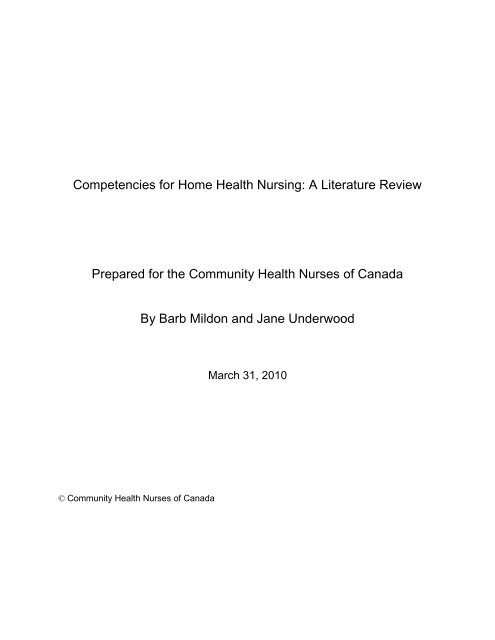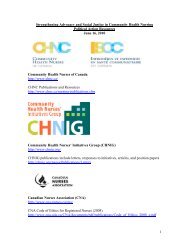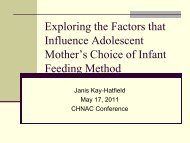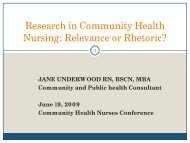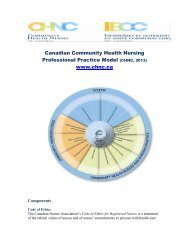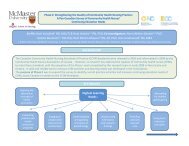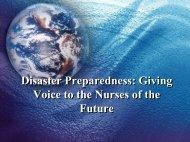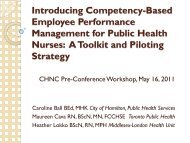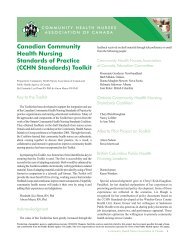Competencies for Home Health Nursing: A Literature Review
Competencies for Home Health Nursing: A Literature Review
Competencies for Home Health Nursing: A Literature Review
Create successful ePaper yourself
Turn your PDF publications into a flip-book with our unique Google optimized e-Paper software.
<strong>Competencies</strong> <strong>for</strong> <strong>Home</strong> <strong>Health</strong> <strong>Nursing</strong>: A <strong>Literature</strong> <strong>Review</strong>Prepared <strong>for</strong> the Community <strong>Health</strong> Nurses of CanadaBy Barb Mildon and Jane UnderwoodMarch 31, 2010© Community <strong>Health</strong> Nurses of Canada
AbstractDefinitions of home health nursing in the literature situate patients, their families andcaregivers as the focus of the practice that attends to acutely ill, chronically ill, andterminally ill patients receiving care at home or other places in the community. Theresults of the literature review presented in this report provide evidence of the vast arrayof diverse competencies required <strong>for</strong> the unique and complex practice of home healthnursing.This review was conducted to in<strong>for</strong>m the development of practice competencies <strong>for</strong>registered nurses working in home health care. The selection of literature was restrictedto content which focused exclusively on home health practice competencies or alludedto specific home health nursing competencies through detailed descriptions of practice,orientation, education or outcomes.The CINAHL and Medline on-line publication databases were searched using the keywords “home care nursing/home health nursing and competence/competency” <strong>for</strong> theyears 1996 to 2009. Reference lists of articles retrieved through the on-line search werereviewed to identify possible other relevant articles. Additionally content regarding homecare nursing practice competencies were accessed in a convenience sample of textbooks. Lastly, experts from the field submitted suggestions about literature <strong>for</strong> thereview. Articles and texts from these multiple sources were scanned <strong>for</strong> relevancy anda total of 105 citations were reviewed: 78 references were ultimately included in thisliterature review.<strong>Competencies</strong> <strong>for</strong> <strong>Home</strong> <strong>Health</strong> <strong>Nursing</strong>: <strong>Literature</strong> <strong>Review</strong> 2
IntroductionThis literature review was conducted to in<strong>for</strong>m the development of practicecompetencies <strong>for</strong> registered nurses working in home health care. The findings of theliterature review provide the background <strong>for</strong> the development of a consensus processamongst experts on a final list of competencies <strong>for</strong> Canadian home care registerednurses. (For further in<strong>for</strong>mation contact: info@chnc.ca)Search StrategyThe CINAHL and Medline on-line publication databases were searched using the keywords “home care nursing/home health nursing and competence/competency” <strong>for</strong> theyears 1996 to 2009. The 1996 start date was chosen as it is recognized as a year inwhich numerous landmark articles were published about home care nursing practicecompetencies.The reference lists of articles retrieved through the on-line search were scanned toidentify possible additional relevant articles which were then retrieved. Content from aconvenience sample of text books regarding home care nursing practice competencieswas also accessed.In addition, suggestions about relevant literature were requested from a conveniencesample of home care experts recommended by Community <strong>Health</strong> Nurses of Canada.These experts submitted suggested resources in the <strong>for</strong>m of articles, web sites or otherresources.Lastly, content-specific publications by key nursing associations such as the Canadian<strong>Nursing</strong> Association, The Community <strong>Health</strong> Nurses of Canada (<strong>for</strong>merly known as theCommunity <strong>Health</strong> Nurses Association of Canada) and the American <strong>Nursing</strong>Association were retrieved and reviewed. For example, Canadian Community <strong>Health</strong><strong>Nursing</strong> Standards of Practice and the Canadian <strong>Nursing</strong> Association Community<strong>Health</strong> <strong>Nursing</strong> Certification Examination <strong>Competencies</strong> reflect the essence ofcommunity health practice and were designed to guide the development of questions <strong>for</strong>the examination and the course of study to prepare <strong>for</strong> the examination.Inclusion CriteriaThe selection of literature was restricted to content which focused exclusively on homehealth practice competencies or alluded to specific home health nursing competenciesthrough detailed descriptions of practice, orientation, education or outcomes.Exclusion CriteriaBasic practice competencies <strong>for</strong> nurses entering the profession such as those set byregulatory colleges are assumed as foundational <strong>for</strong> all nurses and were not accessed.Advanced practice competencies (e.g. <strong>for</strong> the Nurse Practitioner or Clinical NurseSpecialist working in home health nursing) and practice competencies <strong>for</strong> LicensedPractical Nurses (Registered Practical Nurses in Ontario) are outside the scope of this<strong>Competencies</strong> <strong>for</strong> <strong>Home</strong> <strong>Health</strong> <strong>Nursing</strong>: <strong>Literature</strong> <strong>Review</strong> 3
literature review. However, it is recognized that the competencies described may bepartially or fully enacted by LPNs/RPNs depending on their provincial regulatory scopeof practice guidelines and employer protocols. Case management is recognized as aspecific practice focus and the detailed competencies <strong>for</strong> that specialty were notincluded in this literature review. However, some aspects of case management areshared by case managers and home health nurses (HHNs) and competencies related tothose aspects as discussed in the literature are identified.A fundamental competency <strong>for</strong> all nurses is the ability to identify knowledge gaps andaccess the knowledge specific to their unique area of practice. Accordingly, detailedpractice competencies required in specialty home care nursing practice such asadvanced wound care, enterostomal therapy, end-of-life care, or competencies appliedto the care of individuals within unique populations such as the homeless, individuals incorrectional settings, First Nations individuals or bands, and those identifying as gay,lesbian, bisexual or transgender are not included in this literature review.Results of the searchAs a result of the combined search strategies, 105 citations were reviewed. Seventyeight(78) of those citations were assessed as relevant <strong>for</strong> this literature review. Anadditional 27 citations (Appendix B) were excluded because they did not fully meet theinclusion criteria <strong>for</strong> this review.Definition of CompetencyThe definition of competency may be viewed as the hub of a wheel, with the specificcompetencies constituting the spokes. Accordingly, the home health nursing literaturewas searched <strong>for</strong> definitions of competency. Competency was defined by some authorsas the integration of knowledge, abilities, skills and attitudes that enables jobper<strong>for</strong>mance (Blevins, 2001; Buckley, Adelson and Hess, 2005; Nolan, 1998). TheCommunity <strong>Health</strong> Nurses Association of Canada (2008) outlined the multiple types ofknowledge expected of community health nurses including “Aesthetics, Empirics,Personal knowledge, ethics and socio-political knowledge (p. 7).Nolan (1998) specified that competency involves delivering care according to“expectations” (p. 27). Benefield (1998) further elaborated that competency involves“providing services that are both effective and efficient” (p. 25). Astarita, Materna andBlevins (1998) observed that “competency is not a static phenomenon… [but is]ongoing and ever-changing.” Consequently they warned that “competency is not aonce-and-done event [but] needs to be assessed at pre-determined intervals” (p. 135).Blevins (2001) suggested that competency leads to best practices and optimal jobper<strong>for</strong>mance. Blevins also reiterated Benner’s (1984) identification of competency as “adynamic state influenced by experience and education” (p. 114).<strong>Home</strong> <strong>Health</strong> <strong>Nursing</strong>Definitions of home health nursing in the literature situated patients, their families andcaregivers as the focus of the practice that attends to acutely ill, chronically ill, and<strong>Competencies</strong> <strong>for</strong> <strong>Home</strong> <strong>Health</strong> <strong>Nursing</strong>: <strong>Literature</strong> <strong>Review</strong> 4
terminally ill patients receiving care in their residence (American Nurses Association[ANA], 2008); Canadian <strong>Home</strong> Care Association [CHCA], 2008; Murray, 1998).As a component of home care programs or services, home health nursingencompasses disease prevention, rehabilitation, restoration of health, health protectionand health promotion with the goal of managing existing problems and preventingpotential problems (ANA, 2008; CHCA, 2008; CHNAC, 2008; Humphrey, 2002) <strong>Home</strong>care nursing may substitute <strong>for</strong> long-term care or contribute to preventing or delayinglong term care (<strong>Health</strong> Canada, 1999; Schoot, Proot, Legius, ter Meulen and de Witte,2006). <strong>Home</strong> care nursing activities include “teaching, curative interventions, end-of-lifecare, rehabilitation, support and maintenance, social adaptation and integration, andsupport <strong>for</strong> the family caregiver” (CHCA, 2008, p. 2). These activities involve initiating,coordinating, managing and evaluating the resources needed to promote the patient’smaximum level of health and function (ANA, 2008).Promoting patients’ independence and self-sufficiency was reported as a key focus ofhome health nursing (Meyer, 1997; Rice, 1998), with the overriding aim of home healthnursing being to maintain or improve the quality of life <strong>for</strong> patients and their families andother caregivers, or to support patients in their transition to end of life (ANA, 2008).The practice of home care nursing was frequently identified as unique, or as a specialty(ANA, 2008; CHNAC, 2008; Guthaus and White, 2002; Humphrey and Milone-Nuzzo,2005; Murray, 1998). In part, this uniqueness arises from caring <strong>for</strong> patients of all ageswith a diversity of diagnoses and conditions that span the health-illness continuum(Glajchen and Bookbinder, 2001; Gorski, 2008; Kaiser and Rudolph, 1996; Murray,1998). Building on the determinants of health as foundational to practice, home healthnursing integrates “environmental, psychosocial, economic, cultural and personal healthfactors affecting an individual’s and family’s health status” (ANA, p. 3). As communityhealth nurses, HHNs recognize caring as “an essential and universal human need”(CHNAC, 2008, p. 6) and incorporate the principles of social justice and primary healthcare into their practice. Neal (1997) asserts that home health nursing is based in caringand to that end, home health nursing care is holistic in nature, encompassing physical,emotional and spiritual care (Barnett, 2006; Rice, 1998; Witter, 2005).Contextual features of home health nursing abounded in the literature. Examplesincluded “diverse client-centered environments” (Kaiser and Rudolph, 1996, p. 160),treatment of a wide range of patients—“from the elderly to children of all ages (Glajchenand Bookbinder, 2001; Neal, 1997), and the provision and/or management of care <strong>for</strong>patients with a broad array of diagnoses across the lifespan and the health-illnesscontinuum (Gorski, 2008; Kaiser and Rudolph, 1996, p. 158). Working in isolation andthe solitary nature of HHN practice was widely cited (Guthaus and White, 2002; Higuchi,Christensen and Terpstra, 2002; Kihlgren, Fagerberg, Skovdahl, and Kihlgren, 2003).Guthaus and White (2002) identified the unpredictable nature of the home careenvironment. Several authors discussed the contrast between the hospital setting, inwhich patients occupy space controlled by the institution, and the home care setting, inwhich the client is in control and the HHN a guest (Bramadat, Chalmers and<strong>Competencies</strong> <strong>for</strong> <strong>Home</strong> <strong>Health</strong> <strong>Nursing</strong>: <strong>Literature</strong> <strong>Review</strong> 5
3. Das ImmobilienportfolioVERTRAGSMIETRENDITE IN %*> 18,4 Mio. € Fair Value-anteilige Vertragsmiete> Mietrendite vor Kosten von 8,2% bezogen aufFair Value's Anteil am Marktwert*Bezogen auf anteilige Marktwerte per 31. Dezember 2010RESTLAUFZEITEN IN %*> Durchschnittliche Restlaufzeit der Mietverträgevon 6,2 Jahren unterstreicht Stabilität derMieteinnahmen> Vermietungsstand von 93,6% (der Potenzialmietevon 19,7 Mio. €) sichert nachhaltigeErtragskraftStabile Mietertragsbasis*Bezogen auf die Vertragsmiete per 31. Dezember 2010(Fair Value-anteilig)22. Februar 2011Fair Value REIT-AGSeite 6
spiritual and cultural considerations. Environmental assessment focused on the home,exploring safety aspects or risks (Lang et al., 2009; Malone, 2008).In its “Guidelines <strong>for</strong> the Provision of Community <strong>Nursing</strong> Care the Government ofAustralia, Department of Veterans’ Affairs (1997) outlines several specific expectationsregarding nursing per<strong>for</strong>mance of assessment: That the RN assessor possesses specific knowledge, competencies andexperience relating to comprehensive assessment The assessment minimizes duplication by making use of relevant assessmentin<strong>for</strong>mation held by other agencies assisting the client The needs of the client being assessed are determined in conjunction with theclient The assessment is conducted in a safe environment Assessment results are recorded accurately in accordance with specified recordkeeping requirements Clear constructive feed-back is given to clients regarding the assessmentoutcomes Any assessment decision is made with the agreement of the client Confidentiality of the assessment outcome is maintained and access to theassessment records is provided only to authorized personnel.”The competency of expert assessment was often associated with monitoring specificaspects of the patient’s status, e.g. nutrition (Li, Morrow-Howell and Proctor, 2004;Witter, 2005), cardiovascular or respiratory condition (Barnett, 2006; Witter, 2005);effectiveness of pain management (Glajchen and Bookbinder, 2001; Spiers, 2006;Vallerand, Hasenau and Templin, 2004), depression (Purkis and Bjornsdottir, 2006) andsigns and symptoms of clinical deterioration e.g. hypoglycemia or hyperglycemia (Purkisand Bjornsdottir, 2006) or overall symptom management (Quinn, 2001). Monitoring thepatient’s compliance with their treatment plan as a key factor in successfully managinga chronic disease was identified by Reeder (1999).Care PlanningRegistered Nurses’ demonstration of care planning using the nursing process washighlighted by Linekin (2003) who observed that Registered Nurses “<strong>for</strong>mulate patients’plans of care and coordinate implementation of the plan with all health care teammembers (p. 220). <strong>Health</strong> Canada (2002) also identified applying the nursing processas a competency <strong>for</strong> home and community care nurses working in the First Nations Inuit<strong>Health</strong> Community Care Program. The identification of the most appropriate nursingcare strategies or interventions to meet identified outcomes was embedded in careplanning (Hughes, et al., 2002), with those strategies possibly including complementaryand cultural therapies (ANA, 2008; Neal, 1997).Clinical Decision-MakingHiguchi, Christensen and Terpstra (2002) explored the challenges encountered by 16Canadian HHNs in exercising clinical decision-making skills. Recognizing clinicaldecision-making as central to their practice, the strategies HHNs employed to facilitate<strong>Competencies</strong> <strong>for</strong> <strong>Home</strong> <strong>Health</strong> <strong>Nursing</strong>: <strong>Literature</strong> <strong>Review</strong> 7
their decision-making included seeking knowledge about services available to thepatient, collecting additional in<strong>for</strong>mation, adjusting the care plan and consulting withpeers during team meetings. Kihlgren, Fagerberg, Skovdahl and Kihlgren (2003)identified the need <strong>for</strong> community nurses to have expert knowledge and decisionmakingwhen considering whether or not to send elderly patients to the emergencyroom. ANA (2008), Gorski (2008) and O’Neill (1996) also discussed or identified therequirement <strong>for</strong> competence in clinical decision-making.CommunicationCommunication was acknowledged as a competency <strong>for</strong> home health nursing byseveral authors (ANA, 2008; Benefield, 1996; CHNC, 2008; Humphrey, 2002). Barnett(2006) called <strong>for</strong> HHNs to have “effective listening and non-verbal communication skills(p. 2 of 8). Wessel and Rutledge (2005) asserted that “Effective communication withpatients and families on end-of-life issues is a primary competency <strong>for</strong> clinicians” (p.213). Guthaus and White (2002) noted that “communication skills must reflect the abilityof the nurse to relate effectively to diverse patient populations and all levels of careproviders and their gatekeepers across the continuum” (p. 257). They further added thatin contrast to the acute care nurse, who often has direct access to the physician, thehome care nurse must often communicate through a third party, thus adding complexityto the communication process. Finally, Guthaus and White specified that “to avoidinappropriate interventions or changes in treatment plan, communication must bearticulate and present a complete and accurate picture that is delivered with theappropriate sense of urgency” (p. 257).The need to meet documentation requirements of funders and employers wasemphasized by Ellenbecker and Warren (1998) and identified as a complex (Herb,2003) or highly demanding component of home health nursing work (Ellenbecker,Boylan and Samia, 2006). The work of other authors pointed to documentation skills asa sub-set of communication and an important competency <strong>for</strong> HHNs (Benefield, 1996;<strong>Health</strong> Canada, 1996; Herb, 2003; Humphrey, 2002).Establishing and Maintaining the Nurse-Patient RelationshipEstablishing a therapeutic relationship with the patient, including respecting the family’sprivacy and gaining an understanding of client/family expectations, is foundational tohome health nursing (Higuchi, Christensen and Terpstra, 2002; Peter, 2002). Zurmehly(2007) described the nature of the nurse-patient relationship as a “blending ofboundaries between the family and nurse and client” (p. 166). During interviews <strong>for</strong>Zurmehly’s study, nurses “discussed the long-term relationships they developed withtheir home health clients as opposed to the relationships they have with patients whohave short stays in the acute care setting. Many shared how their relationship created aspecial bond and the nurse became an extension of the family” (Zurmehly, 2007, p.166). In palliative care, the nurse-patient relationship was depicted as “central to therole of the nurse and the <strong>for</strong>ming [of] an effective partnership” (Barnett, 2006, p. 2 of 8).Inherent in the nurse-patient relationship is the nurse’s care to maintain confidentiality,safety, security, dignity and respect <strong>for</strong> both patient and family (ANA, 2008, p. 18). This<strong>Competencies</strong> <strong>for</strong> <strong>Home</strong> <strong>Health</strong> <strong>Nursing</strong>: <strong>Literature</strong> <strong>Review</strong> 8
duty on the nurse’s part reflects ethical practice—another practice expectation (ANA,2008; CHNC, 2008; <strong>Health</strong> Canada, 2002).Practice Skills/<strong>Nursing</strong> Care InterventionsThe requirement <strong>for</strong> expertise in a range of nursing care interventions was revealed bythe literature review. Medication management involving the monitoring or administrationof medications and therapies appeared in several publications (ANA, 2008; Guthausand White, 2002; <strong>Health</strong> Canada, 2002; Inglis et al., 2004; Kovner, Menezes andGoldberg, 2005; Li, Morrow-Howell and Proctor, 2004; Murashima et al., 2002; Reeder,1999). HHNs also provide, or support the patient’s self care in a myriad of specificinterventions including injections, kidney dialysis, parenteral nutrition, chemotherapy,stoma care, wound care, strategies to address mental health needs and care of patientson respirators or oxygen therapy (Herleman, 2008; Murashima et al., 2002; Shy, Liao,Shao and Yang, 1999).Patient teaching and education also received attention (ANA, 2008; Gorski, 2008;Hughes et al., 2002; Humphrey, 2002; Inglis, 2004; Murashima et al., 2002). Zurmehly(2007) found that nurses did a significant amount of teaching and shared one nurse’sreflection that: “I teach not only the client but also the whole family or sometimes theneighbour” (p. 167). Teaching as an intervention was evident in the description of thedevelopment of a “nurse-directed, multidisciplinary intervention that included educationabout Congestive Heart Failure and its treatment” (Li, Morrow-Howell and Proctor, p.276). Extending the notion of teaching was the expectation by Bramadat, Chalmers andAndrusyszyn (1996) <strong>for</strong> the nurse to be competent with patient counseling. Competencyin teaching peers through orientation and preceptorship was also evident in theliterature (DeCicco, 2008; Gavin, Haas, Pendleton, Street and Wormald, 1996;Humphrey, 2002; Meadows, 2009).Cultural CompetencyAlthough a requirement of all nurses in all settings and roles, cultural competency asdemonstrated by the nurse’s use of “culturally acceptable and relevant approaches(Kaiser et al., 2003, p. 194) received focused attention in the home health literature(ANA, 2008; Edmunds and Kinnaird-Iler, 2008; Frable, Wallace and Ellison, 2004;Romeo, 2007). Thobaben (2004) called upon HHNs to provide culturally competentcare, while Kaiser and Rudolph (1996) further elaborated that the nurse [needs to]consider the patient’s “age and culture [in devising] approaches to learning needs” (p.160). Romeo (2007) documented the journey and specific activities undertaken by aU.S. home health agency to meet specific standards regarding the provision of culturallycompetent care. Chenoweth et al. (2006) asserted:“A culturally competent nurse recognizes and understands the impact that theirown cultural and professional beliefs have on workplace practices…andrecognizes that cultural differences occur across all levels of diversity, bothprimary (age, gender, language, physical ability and sexual preference) andsecondary (socio-economic background, geographical location, education andreligion). This nurse will recognize the essential humanity in all persons whatever<strong>Competencies</strong> <strong>for</strong> <strong>Home</strong> <strong>Health</strong> <strong>Nursing</strong>: <strong>Literature</strong> <strong>Review</strong> 9
their cultural background and there<strong>for</strong>e will need to learn how to interacteffectively with people in providing quality care, despite different socialbackgrounds, cultures, religions and lifestyle preferences” (p. 36).A study involving relatives of terminally ill Turks and Moroccans in the Netherlands (deGraaff and Francke, 2003) illustrated the benefits of nurses’ cultural competency. Theauthors speculated that relatives’ higher level of satisfaction with the communication ofhome health nurses was related to HHNs’ knowledge of, and adherence to “unwrittenrules… [embedded in] culturally defined patterns of behaviours” (p. 803).Evidence-Based PracticeHHNs’ competency in evidence-based practice, including keeping their clinicalknowledge current, was illustrated by Purkis and Bjornsdottir (2006) who observed that“the nurse is trans<strong>for</strong>ming the evidence that she brings to the home” (p. 249) … andkeeping “up with new ideas and in<strong>for</strong>mation, while being confident in her judgment ofthe validity and utility of all of this <strong>for</strong> her local situation” (p. 255). Witter (2005) declaredthat “Programs must incorporate practice guidelines, clinical pathways and other tools…[and that the nurse must] collect and analyze variances from expected interventions andoutcomes (p. 39). Other support <strong>for</strong> including evidence-based practice as acompetency was provided by Inglis et al. (2004) who called on nurses to applyguidelines to ensure optimal management of [patients’] chronic conditions whereappropriate. The experience of using clinical guidelines and evidence-based protocols<strong>for</strong> patients with heart failure was shared by Ervin, Scrivener and Simons (2004).Frable, Wallace and Ellison (2004) discussed utilization of guidelines <strong>for</strong> patients withdiabetes.Organizational <strong>Competencies</strong>Time management and organizational skillsTime management and organizational skills were identified as competencies <strong>for</strong> HHNsby multiple authors (ANA, 2008; Benefield, 2000; Sherry, 1996; Zurmehly, 2007). Theseskills influence the nurse’s productivity. Benefield (1996; 1998) explained thatproductivity encompasses the effectiveness and efficiency of the service. Efficiency isviewed as the time it takes <strong>for</strong> the nurse to complete the visit activities, witheffectiveness referring to the outcomes associated with the services provided.Humphrey (2002a) declared that the system <strong>for</strong> measuring productivity as a specifiednumber of visits per day is inadequate and called <strong>for</strong> productivity expectations to takeinto consideration the competencies of the clinicians to “provide the care and reach thenecessary clinical outcomes” (p. 743).Care CoordinationCare coordination was identified by Inglis et al. (2004) as “Optimizing patient access toeffective multidisciplinary management (involving their primary care physician, specialistphysician, community pharmacist, community nurse, and other allied healthprofessionals where appropriate) with clear treatment and outcome goals” (p. 121).Evidence that HHNs require competency in care coordination (also called case or care<strong>Competencies</strong> <strong>for</strong> <strong>Home</strong> <strong>Health</strong> <strong>Nursing</strong>: <strong>Literature</strong> <strong>Review</strong> 10
management) was provided by Guthaus and White (2002), Humphrey (2002),Murashima et al (2002) and Witter (2005).Herleman (2008) undertook a detailed review of the HHN’s role in managing the care <strong>for</strong>their patients which she characterized as case management. The review identified fivekey components of case management: 1) coordination of care; 2) ensuring continuity ofcare; 3) identifying changes in the patient’s condition; 4) evaluating the care beingdelivered in association with health care team members and 5) being aware of andunderstanding the financial implications of the care plan. The author advocated <strong>for</strong> astructured case management process and presented associated <strong>for</strong>ms and tools.Some literature sources linked competence in care coordination with the competency ofsupervision and delegation—e.g. of patient care activities to Licensed Practical Nurses(LPNs) and <strong>Home</strong> <strong>Health</strong> Aides (Gorski, 2008; Kihlgren, Fagerberg, Skovdahl, andKihlgren, 2003; Timm, 2003). Timm (2003) elaborated upon the competency ofsupervision and delegation, specifying that it involves the components of delegatingtasks that fit the educational preparation and ability of the LPN or Aides, providingdirection and assistance, observing and monitoring the activities of those supervisedand evaluating the effectiveness of the care per<strong>for</strong>med.Making ReferralsIntegral to care coordination is the competency of identifying and making referrals tocommunity resources (ANA, 2008; <strong>Health</strong> Canada, 2002; Purkis and Bjornsdottir, 2006).Zurmehly (2007) observed that “The community nurse must coordinate total care <strong>for</strong> theclient, family and community in an autonomous manner with an ultimate goal of healthand well-being” (p. 169). However the author stressed that it is the client who definesthe meaning of health and well-being.Proficiency with Complex TechnologyThe need to maintain competence in working with complex technology was evident inthe literature (ANA, 2008; Murray, 1998). Reeder (1999) called on nurses to be able to“access in<strong>for</strong>mation in [technological] systems in real time” (p. 44) and managetelemonitoring and virtual home visits as well as email, faxing and intranet systems.Demiris, Oliver and Courtney (2006) discussed ethical considerations that HHNs shouldbe aware of regarding the use of telehealth technologies in home and hospice care. Li,Morrow-Howell and Proctor (2004) discussed telephone follow-up as an intervention,and Buckley, Adelson and Hess (2005) described a wound care photographyintervention by nurses. Eck-Casteels (2007) reviewed advances in technology that arebeginning to find their way into home care and Struk (2002) described the needs ofclinicians as the end users of home care computer technology.Quality CareSeveral literature sources identified the nurse’s role in quality care (ANA, 2008; <strong>Health</strong>Canada, 2002; Reeder, 1999). Specific activities include participating in riskmanagement and quality improvement activities and critical incident reviews, evaluating<strong>Competencies</strong> <strong>for</strong> <strong>Home</strong> <strong>Health</strong> <strong>Nursing</strong>: <strong>Literature</strong> <strong>Review</strong> 11
personal per<strong>for</strong>mance and contributing to the evaluation and measurement of outcomesof care. Herleman (2008) included monitoring the quality of care in the dutiesencompassed by case management.System <strong>Competencies</strong>Patient AdvocacyActing as a patient advocate was discussed in several sources (ANA, 2008; Benefield,1997; CHCA, 2005; CHNC, 2009; Gorski, 2008; Rice, 1998). Rice advised thatadvocacy involved insisting on “sufficient time and resources to facilitate self-care. Forexample [if there is] a limited number of home visits, although the patient clearlyrequires more care, nurses may need to voice concerns about abandoning a sickpatient, as well as pointing out the economic advantages of making a few more visits tokeep the patient out of more costly systems like the hospital ”(p. 53). Rice’s discussionwas echoed by Humphrey (2002) who likewise identified that pressure on the nurse towork within average or expected visit numbers may adversely impact patient outcomes.Flynn (2007) found that approximately 20 percent of HHNs were not confident in theirpatient’s ability to self-manage care after discharge from home care.Influencing legislative and regulatory processes may be linked to advocacy and wasidentified as a competency <strong>for</strong> HHNs by the American Nurses Association (2008).Additionally CHNC (2009) identified policy development as a competencySystem KnowledgeKnowledge and compliance with existing regulations and legislation, and advancedknowledge of financial and regulatory aspects of care was specifically identified by theAmerican Nurses Association (2008) and Astarita, Materna and Blevins (1998).However acceptance of this competency as foundational to practice was a threadthroughout much of the literature.Organizing Frameworks <strong>for</strong> <strong>Home</strong> <strong>Health</strong> <strong>Nursing</strong> <strong>Competencies</strong>More than a dozen organizing frameworks or itemized lists <strong>for</strong> home health nursingcompetencies were identified during the course of this literature review (Appendix A).The existence of so many frameworks speaks to the challenge of organizingcompetencies in a framework that is practical yet comprehensive and meaningful.Conclusion and RecommendationsThe results of the literature review presented in this report have provided evidence ofthe vast array of diverse competencies required <strong>for</strong> the unique and complex practice ofhome health nursing. Canadian HHNs are broadly familiar with the CanadianCommunity <strong>Health</strong> <strong>Nursing</strong> Standards of Practice, and those standards convey thedepth and breadth of HHN practice. Accordingly, it is recommended that the CanadianCommunity <strong>Health</strong> <strong>Nursing</strong> Standards of Practice be adapted as needed and utilized asthe organizing framework <strong>for</strong> the finalized HHN practice-specific competencies.<strong>Competencies</strong> <strong>for</strong> <strong>Home</strong> <strong>Health</strong> <strong>Nursing</strong>: <strong>Literature</strong> <strong>Review</strong> 12
-----------<strong>Competencies</strong> <strong>for</strong> <strong>Home</strong> <strong>Health</strong> <strong>Nursing</strong>: <strong>Literature</strong> <strong>Review</strong> 13
ReferencesAmerican Nurses Association [ANA] (2008). <strong>Home</strong> health nursing: Scope and standardsof practice.Maryland: AuthorAstarita, T., Materna, G., & Blevins, C. (1998). Competency in home care. Maryland:Aspen.Barnett, M. (2006). Providing palliative care in end-stage COPD within primary care.Journal of Community <strong>Nursing</strong>, 20, 30-34.Benefield, L.E. (1996). Component analysis of productivity in home care RNs. Public<strong>Health</strong> <strong>Nursing</strong>, 13(4), 233-243.Benefield, L.E. (1997). Are you really ready <strong>for</strong> home health nursing? AJN.Benefield, L.E. (1998). <strong>Competencies</strong> of effective and efficient home care nurses. <strong>Home</strong>Care Manager, 2(3), 25-28.Benefield, L.E. (2000) Critical competencies <strong>for</strong> nurses in the new millennium. <strong>Home</strong><strong>Health</strong>care Nurse, 18(1), 17-21.Benner, P. (1984). From novice to expert: Excellence and power in clinical nursingpractice. Menlo Park: Addison-Wesley.Blevins, C. (2001). There really is a difference: <strong>Home</strong> care competencies. Journal ofContinuing Education in <strong>Nursing</strong>, 32(3), 114-7.Boucher, M.A. (2005). “Making it”—Qualities needed <strong>for</strong> rural home care nursing. <strong>Home</strong><strong>Health</strong>care Nurse, 23(2), 103-108.Bramadat, I.J., Chalmers, K., & Andrusyszyn, M.A. (1996). Knowledge, skills andexperiences <strong>for</strong> community health nursing practice: The perceptions ofcommunitynurses, administrators and educators. Journal of Advanced <strong>Nursing</strong>, 24, 1224-1233.Buckley, K.M., Adelson, L.K. & Hess, C. T. (2005). Get the picture! Developing awound photography competency <strong>for</strong> home care nurses. Journal of Wound Care<strong>Nursing</strong>, 32(3), 171-177.Canadian <strong>Home</strong> Care Association (2005). Summary of proceedings from the home carecase management invitational roundtable. Ottawa: Author. Retrieved Jan. 5,2010 fromhttp://www.hc-sc.gc.ca/hcs-sss/pubs/home-domicile/2005-cas-mgmt-gest/indexeng.phpCanadian <strong>Home</strong> Care Association (2008). <strong>Home</strong> care. The next essential service:Meeting the needs of our aging population. Ottawa: Author. Retrieved January 6,2010from http://www.cdnhomecare.ca/media.php?mid=1914Chenoweth, L., Jeon, Y.-H., Goff, M. & Burke, C. (2006). Cultural competency andnursing care: An Australian perspective. International <strong>Nursing</strong> <strong>Review</strong>, 53, 34-40.Coffman, S. (1997). <strong>Home</strong>-care nurses as strangers in the family. Western Journal of<strong>Nursing</strong> Research, 19(1), 82-96.Community <strong>Health</strong> Nurses Association of Canada [CHNAC](2008). Canadiancommunity health nursing standards of practice. Toronto: Author.<strong>Competencies</strong> <strong>for</strong> <strong>Home</strong> <strong>Health</strong> <strong>Nursing</strong>: <strong>Literature</strong> <strong>Review</strong> 14
Community <strong>Health</strong> Nurses of Canada [CHNC](2009). Public health nursing disciplinespecificcompetencies version 1.0. Ottawa: Author.DeCicco, J. (2008). Developing a preceptorship/mentorship model <strong>for</strong> home healthnurses. Journal of Community <strong>Health</strong> <strong>Nursing</strong>, 25, 1, 15-25.De Graaff, F.M. & Francke, A.L. (2003). <strong>Home</strong> care <strong>for</strong> terminally ill Turks andMoroccans andtheir families in the Netherlands: Carers’ experiences and factors influencingease of access and use of services. International Journal of <strong>Nursing</strong> Studies, 40,797-805.Demiris, G., Oliver, D.P., & Courtney, K.L. (2006). Ethical considerations <strong>for</strong> theutilization oftelehealth technologies in home and hospice care by the nursing profession.<strong>Nursing</strong> Administration, 30(1), 56-66.Eck-Casteels, H. (2007). Go home and get well soon. <strong>Health</strong>care Quarterly, 10, 1-3.Edmunds, K. & Kinnaird-Iler, ElK. (2008). Multicultural clients. In Stamler, L. & Yiu, L.(Eds.) (2008). Community health nursing: A Canadian perspective. (2 nd Ed.),Chapter 20,pp. 311-319.Ellenbecker, C.H. & Warren, K. (1998). <strong>Nursing</strong> practice and patient care in a changinghomehealthcare environment. <strong>Home</strong> <strong>Health</strong>care Nurse, 16(8), 531-539.Ellenbecker, C.H., Boylan, L.N. & Samia, L. (2006). What home healthcare nurses aresayingabout their jobs. <strong>Home</strong> <strong>Health</strong>care Nurse, 24(5), 315-324.Ervin, N.E., Scrivener, K., & Simons, T. (2004). Using the linkage model <strong>for</strong> integratingevidence into home care nursing practice. <strong>Home</strong> <strong>Health</strong>care Nurse, 22(9), 606-611.Flynn, L. (2007). Managing the care of patients discharged from home health: A quietthreat topatient safety? <strong>Home</strong> <strong>Health</strong>care Nurse, 25(3), 184-190.Frable, P.J., Wallace, D.C. & Ellison, K.J. (2004). Using clinical guidelines in home care<strong>for</strong>patients with diabetes. <strong>Home</strong> <strong>Health</strong>care Nurse, 22(7), 462-468.Gavin, M.J., Haas, L.J., Pendleton, P.B., Street, J.W., & Wormald, A. (1996). Orientinga newgraduate nurse to home healthcare. <strong>Home</strong> <strong>Health</strong>care Nurse, 14(5), 381-387.Glajchen, M. and Bookbinder, M. (2001). Knowledge and perceived competence ofhomecare nurses in pain management: A national survey. Journal of Pain andSymptomManagement, 21(4), 307-316.Gorski, L. (2008). Implementing home health standards in clinical practice: An overviewof the updated standards. <strong>Home</strong> <strong>Health</strong>care Nurse, 26(5), 308-16.Government of Australia, Department of Veterans Affairs (1997). Guidelines <strong>for</strong> the<strong>Competencies</strong> <strong>for</strong> <strong>Home</strong> <strong>Health</strong> <strong>Nursing</strong>: <strong>Literature</strong> <strong>Review</strong> 15
provision of community nursing care, Section Two: Client classification system.Australia: Author.Guthaus, M.A. & White, D. (2002). Blending the roles of home care nursing andcardiovascularspecialties: A model <strong>for</strong> nursing practice in the community. <strong>Home</strong> <strong>Health</strong> CareManagement and Practice, 14(4), 255-261.<strong>Health</strong> Canada (1999). Provincial and territorial home care programs: A synthesis <strong>for</strong>Canada. Ottawa: Author. Retrieved January 7, 2010 from http://www.hcsc.gc.ca/hcs-sss/pubs/home-domicile/1999-pt-synthes/definition-eng.php<strong>Health</strong> Canada (2002). Standards and competencies <strong>for</strong> FNIHCC home care nursingservices <strong>for</strong> British Columbia. Ottawa: Author.Herb, S. (2003). The evolution of documentation in home health. <strong>Home</strong> <strong>Health</strong> CareManagement & Practice, 16(1), 41-45.Herleman, L. (2008). <strong>Home</strong> care primary nurse case management model. <strong>Home</strong> <strong>Health</strong>CareManagement and Practice, 20(3), 235-244.Higuchi, K.A, Christensen, A. & Terpstra, J. (2002). Challenges in home care practice: Adecision-making perspective. Journal of Community <strong>Health</strong> <strong>Nursing</strong>, 19(4), 225-236.Hughes, L.C., Robinson, L.A., Cooley, M.E., Nuamah, I., Grobe, S.J. & McCorkle, R.(2002).Describing an episode of home nursing care <strong>for</strong> elderly postsurgical cancerpatients. <strong>Nursing</strong> Research, 51(2), 110-118.Humphrey, C.J. (2002). The current status of home care nursing practice: Part 1:Clinicalpractice under PPS. <strong>Home</strong> <strong>Health</strong>care Nurse, 20(10), 677-684.Humphrey, C.J. (2002a). The current status of home care nursing practice: Part 2:Operationaltrends and future challenges. <strong>Home</strong> <strong>Health</strong>care Nurse, 20(11), 741-747.Humphrey, C.J. & Milone-Nuzzo, P. (2005). Transitioning nurses to home care. InHarris, M.D.(Ed). Handbook of <strong>Home</strong> <strong>Health</strong> Care Administration, (4 th Ed.), (pp. 484-494).Inglis, S., McLennan, S., Dawson, A., Birchmore, L., Horowitz, J.D., Wilkinson, D. &Stewart, S. (2004). A new solution <strong>for</strong> an old problem? Effects of a nurse-led,multidisciplinary, home-based intervention on readmission and mortality inpatients withchronic atrial fibrillation. Journal of Cardiovascular <strong>Nursing</strong>, 19(2), 118-127.Kaiser, K.L. & Rudolph, E.J. (1996). In search of meaning: Identifying competenciesrelevant to evaluation of the community health nurse generalist. Journal of<strong>Nursing</strong>Education, 35(4), 157-162.Kaiser, K.L., Barr, K.L., & Hays, B.J. (2003). Setting a new course <strong>for</strong> advanced practicecommunity/public health nursing. Journal of Professional <strong>Nursing</strong>, 19(4), 189-196.Kihlgren, A.L., Fagerberg, I., Skovdahl, K., & Kihlgren, M. (2003). Referrals from homecare to<strong>Competencies</strong> <strong>for</strong> <strong>Home</strong> <strong>Health</strong> <strong>Nursing</strong>: <strong>Literature</strong> <strong>Review</strong> 16
emergency hospital care: Basis <strong>for</strong> decisions. Journal of Clinical <strong>Nursing</strong>, 12, 28-36.Koch, M. (1997). Going home: Is home health care <strong>for</strong> you? Learn what it takes to be ahome health care nurse. <strong>Nursing</strong>97, October, p.49.Koehler, J.A., Cha, J., & Smith, C.E. (2002). A model <strong>for</strong> using novel nursinginterventions tomeet the challenges of community health needs. <strong>Home</strong> <strong>Health</strong> CareManagement & Practice, 14(2), 129-136.Kovner, C., Menezes, J., & Goldberg, J.D. (2005). Examining nurses’ decision process<strong>for</strong>medication management in home care. Journal on Quality and Patient Safety,31(7), 379-385.Lang, A., Macdonald, M., Storch, J., Elliott, K., Stevenson, L., Lacroix, H., Donaldson,S., Corsini-Munt, S., Francis, F., & Curry, C.G. (2009). <strong>Home</strong> care safetyperspectivesfrom clients, family members, caregivers and paid providers. <strong>Health</strong>careQuarterly, 12,97-101.Li, H., Morrow-Howell, N. & Proctor, E.K. (2004). Post-acute home care and hospitalreadmission of elderly patients with congestive heart failure. <strong>Health</strong> & Socialwork, 29(4), 275-285.Linekin, P.L. (2003). <strong>Home</strong> health care and diabetes assessment, care and education.Diabetes Spectrum, 16(4), 217-8, 220, 222.Malone, M.M. (2008). Violence in families. In Stamler, L. & Yiu, L. (Eds.) (2008).Community health nursing: A Canadian perspective. (2 nd Ed.), Chapter 26, pp.368-376.Meadows, C. (2009). Integrating new graduate nurses in home health care. <strong>Home</strong><strong>Health</strong>careNurse, 27(9), 561-568.Meyer, K.A. (1997). An educational program to prepare acute care nurses <strong>for</strong> atransition tohome health care nursing. The Journal of Continuing Education in <strong>Nursing</strong>, 28(3),124-129.Murashima, S., Nagata, S., Magilvy, J.K., Fukui, S., & Kayama, M. (2002). <strong>Home</strong> carenursingin Japan: A challenge <strong>for</strong> providing good care at home. Public <strong>Health</strong> <strong>Nursing</strong>,19(2), 94-103.Murray, T.A. (1998). From outside the walls: A qualitative study of nurses who recentlychanged from hospital-based practice to home health care nursing. Journal ofContinuingEducation in <strong>Nursing</strong>, 29(2), 55-60.Neal, L. (1997). Current clinical practice of home care nursing. <strong>Home</strong> <strong>Health</strong>care Nurse,15(12),881-882.<strong>Competencies</strong> <strong>for</strong> <strong>Home</strong> <strong>Health</strong> <strong>Nursing</strong>: <strong>Literature</strong> <strong>Review</strong> 17
Nolan, P. (1998). <strong>Competencies</strong> drive decision making. <strong>Nursing</strong> Management, 29(3),27- 40.O’Neill, E.S. (1996). An exploratory study of clinical decision making in home healthcare nursing. <strong>Home</strong> <strong>Health</strong>care Nurse, 14(5), 362-368.Pastor, D.K. (2006). <strong>Home</strong> sweet home: A concept analysis of home visiting. <strong>Home</strong><strong>Health</strong>careNurse, 24(6), 389-394.Peter, E. (2002). The history of nursing in the home: Revealing the significance of placein the expression of moral agency. <strong>Nursing</strong> Inquiry, 9(2), 65-72.Purkis, M.E. & Bjornsdottir, K. (2006). Intelligent nursing: Accounting <strong>for</strong> knowledge asaction in practice. <strong>Nursing</strong> Philosophy, 7, 247-256.Quinn, C. (2001). Analysis of the home health symptom management model.Lippincott’s CaseManagement, 6(3), 104-111.Reeder, L. (1999). Anatomy of a disease management program. <strong>Nursing</strong> Management,30, 41-46.Rice, R. (1998). Key concepts of self-care in the home: Implications <strong>for</strong> home carenurses. Geriatric <strong>Nursing</strong>, 19(1), 52-54.Romeo, C. (2007). Caring <strong>for</strong> culturally diverse patients: One agency’s journey towardculturalcompetence. <strong>Home</strong> <strong>Health</strong>care Nurse, 25(3), 206-213.Schoot, T., Proot, I., Legius, M., ter Meulen, R., & de Witte, L. (2006). Client-centeredhome care: Balancing between competing responsibilities. Clinical <strong>Nursing</strong>Research, 15(4), 231-254.Sherry, D. (1996). Time management strategies <strong>for</strong> the new home care nurse. <strong>Home</strong><strong>Health</strong>careNurse, 14(9), 718-720.Shyu, Y.L., Liao, M., Shao, J., & Yang, C. (1999). A survey of home nursing services inTaiwan.Public <strong>Health</strong> <strong>Nursing</strong>, 16(6), 432-440.Spiers, J.A. (2002). The interpersonal contexts of negotiating care in home care nursepatientinteractions. Qualitative <strong>Health</strong> Research, 12(8), 1033-1057.Spiers, J. (2006). Expressing and responding to pain and stoicism in home-care nursepatientinteractions. Scandinavian Journal of Caring Science, 20, 293-301.Struk, C. (2002). The end user of home care computer technology…the clinician. <strong>Home</strong><strong>Health</strong>care Nurse, 20(7), 466-469.Thobaben, M. (2004). Strategies home health care providers can use to help decreaseminority health disparities. <strong>Home</strong> <strong>Health</strong> Care Management & Practice, 17(1), 56-57.Timm, S.E. (2003). Effectively delegating nursing. <strong>Home</strong> <strong>Health</strong>care Nurse, 21(4), 260-265.Vallerand, A.H., Hasenau, S.M., & Templin, T. (2004). Barriers to pain management byhomecare nurses. <strong>Home</strong> <strong>Health</strong>care Nurse, 22(12), 831-840.<strong>Competencies</strong> <strong>for</strong> <strong>Home</strong> <strong>Health</strong> <strong>Nursing</strong>: <strong>Literature</strong> <strong>Review</strong> 18
Wessel, E.M. & Rutledge, D.N. (2005). <strong>Home</strong> care and hospice nurses’ attitudes towarddeath and caring <strong>for</strong> the dying: Effects of palliative care education. Journal ofHospiceand Palliative <strong>Nursing</strong>, 7(4), 212-218.Witter, P. (2005). The district nurse’s role in managing patients with heart failure.<strong>Nursing</strong> Standard, 19(24), 38-42.Zurmehly, J. (2007). A qualitative case study review of role transition in communitynursing. <strong>Nursing</strong> Forum, 42(4), 162-170.<strong>Competencies</strong> <strong>for</strong> <strong>Home</strong> <strong>Health</strong> <strong>Nursing</strong>: <strong>Literature</strong> <strong>Review</strong> 19
Appendix AOrganizing Frameworks <strong>for</strong> <strong>Home</strong> <strong>Health</strong> <strong>Competencies</strong> or StandardsAuthor(s) orSourceAmerican NursesAssociation(ANA)(2008).Association of<strong>Nursing</strong> Directorsand Supervisors ofOntario Official<strong>Health</strong> Agencies(ANDSOOHA), etal. (1985).Benefield, L.(1996).Title and Framework <strong>for</strong> the <strong>Competencies</strong> or Standards<strong>Home</strong> <strong>Health</strong> <strong>Nursing</strong> Scope & Standards of PracticeI Standards of Practice1. Assessment2. Diagnosis3. Outcomes identification4. Planning5. Implementation-Coordination of care-<strong>Health</strong> teaching and health promotion-Consultation-Prescriptive authority and treatment6. EvaluationII Standards of Professional Per<strong>for</strong>mance7. Quality of practice8. Education9. Professional practice evaluation10. Collegiality11. Collaboration12. Ethics13. Research14. Resource utilization15. LeadershipStandards of <strong>Nursing</strong> Practice <strong>for</strong> Community <strong>Health</strong> Nursesin Ontario (Also known as “The Blue Book)Standards (organized by nursing process framework)1. Assessing2. Planning3. Implementing4. Evaluating5. Professional AccountabilityComponent Analysis of Productivity in <strong>Home</strong> Care RNs1. Knowledge and Ability Variables2. Client/family Management3. Practice Management4. Knowledge/Skill Maintenance5. Communication6. <strong>Nursing</strong> Process7. Written Documentation8. <strong>Home</strong> <strong>Health</strong> Care Knowledge<strong>Competencies</strong> <strong>for</strong> <strong>Home</strong> <strong>Health</strong> <strong>Nursing</strong>: <strong>Literature</strong> <strong>Review</strong> 20
Author(s) orSourceBenefield, L.E.(1998).Bramadat,Chalmers &Andrusyszyn,(1996).Title and Framework <strong>for</strong> the <strong>Competencies</strong> or Standards<strong>Competencies</strong> of Effective and Efficient <strong>Home</strong> Care Nurses1. Cognitive Knowledge that includes the recall or recognition of facts, and thedevelopment of intellectual methods <strong>for</strong> dealing with a new problemor situation2. Psychomotor Manual dexterity of the nurse Ability to give an injection Actual physical process of osculating breath sounds Mechanics of inserting a nasogastric tube Physical process of changing a dressing3. Affective (the caring part of nursing) Therapeutic touch Demonstrating empathy during conversations with a client Maintaining client privacy Communicating to seek the client’s perspective while not imposing thenurse’s own values on the client and family4. Effectiveness The degree to which the nurse has accomplished intended agencygoals related to managing and providing home care to a client5. Efficiency The production of home visits and associated activities related to thehome visit without time or material waste Time saving techniques during the home visits Conscious management of resources to avoid material or time wasteKnowledge, Skills and Experiences <strong>for</strong> CHN PracticeNew CHNs need: Inquiring mind Background in change theory People skills Counseling skills <strong>Health</strong> assessment including assessment of individuals, families andcommunities Knowledge of ethics Cultural awareness Interviewing skills Follow through from hospital to community and communitypreparation <strong>for</strong> hospitalization<strong>Competencies</strong> <strong>for</strong> <strong>Home</strong> <strong>Health</strong> <strong>Nursing</strong>: <strong>Literature</strong> <strong>Review</strong> 21
Author(s) orSourceCanadian NursesAssociation(CNA) (2009).Canadian Public<strong>Health</strong>Association(CPHA) (1990).Title and Framework <strong>for</strong> the <strong>Competencies</strong> or StandardsCommunity <strong>Health</strong> <strong>Nursing</strong> Certification ExamDevelopment Guidelines/List of <strong>Competencies</strong>1. Facilitating Access to Services in an Efficient and Effective Manner2. Restoring and Maintaining <strong>Health</strong> and Providing End-of-Life Care3. Promoting <strong>Health</strong> and Preventing Illness and Injury of VulnerableIndividuals, Populations, Aggregates and Targeted Groups within theCommunity4. Promoting <strong>Health</strong> and Wellness across the Lifespan5. Providing Infection Prevention and Control and Communicable DiseaseServices6. Being Involved in Emergency Preparedness/Disaster Management7. Promoting a <strong>Health</strong>y Environment8. Building Community Capacity to Improve <strong>Health</strong>9. Demonstrating Professional Responsibility and AccountabilityCommunity <strong>Health</strong>--Public <strong>Health</strong> <strong>Nursing</strong> in Canada:Preparation & Practice (Also known as “The Green Book”)1. Roles Role in <strong>Health</strong> Promotion Role in Illness and Injury Prevention2. ActivitiesI Care/Service ProviderII EducatorIII ConsultantIV Community DeveloperV Facilitator-Leader-Enabler-AdvocateVI CommunicatorVII Resource Manager, Planner, CoordinatorVIII Team Member/CollaboratorIX Research/EvaluatorX Social MarketerXI Policy Formulator3. <strong>Competencies</strong> Knowledge Skills Attitudes and Personal Qualities<strong>Competencies</strong> <strong>for</strong> <strong>Home</strong> <strong>Health</strong> <strong>Nursing</strong>: <strong>Literature</strong> <strong>Review</strong> 22
Author(s) orSourceCommunity<strong>Health</strong> NursesAssociation ofCanada (CHNAC)(2003; 2008).Community<strong>Health</strong> Nurses ofCanada (CHNC)(2009).<strong>Health</strong> Canada(2002).Title and Framework <strong>for</strong> the <strong>Competencies</strong> or StandardsCanadian Community <strong>Health</strong> <strong>Nursing</strong>Standards of Practice1. Promoting <strong>Health</strong> <strong>Health</strong> Promotion Prevention and <strong>Health</strong> Protection <strong>Health</strong> Maintenance, Restoration and Palliation2. Building Individual/Community Capacity3. Building Relationships4. Facilitating Access and Equity5. Demonstrates Professional Responsibility and AccountabilityPublic <strong>Health</strong> <strong>Nursing</strong> Discipline Specific <strong>Competencies</strong>1. Public health and nursing sciences2. Assessment and analysis3. Policy Development, Program planning, implementation and evaluation4. Partnerships, collaboration and advocacy5. Diversity and inclusiveness6. Communication7. Leadership8. Professional responsibility and accountabilityStandards and <strong>Competencies</strong> <strong>for</strong> FNIHCC (First Nationsand Inuit <strong>Home</strong> and Community Care) <strong>Home</strong> Care <strong>Nursing</strong>Services <strong>for</strong> British Columbia.1. (Standard) Responsibility and Accountability: Maintains standardsof nursing practice and professional behaviour determined by theNurses (Registered) Act, RNABC and practice setting.<strong>Competencies</strong> Demonstrates responsibility and accountability <strong>for</strong> practice at alltimes Participates in activities to improve the quality of HCN delivery Follows local Band’s or collectivity’s policies In collaboration with others, develops and monitors program andcare standards.2. Specialized body of knowledge: Bases practice on nursing scienceand on related content from other sciences and humanities.<strong>Competencies</strong> Demonstrates an understanding of the administrative structure of thehealth department within the local band’s or collectivity’s healthunits Demonstrates an understanding of the band’s home and communitycare program philosophy, mission goals Demonstrates an understanding of the role, responsibilities andcompetencies of the home care nurse<strong>Competencies</strong> <strong>for</strong> <strong>Home</strong> <strong>Health</strong> <strong>Nursing</strong>: <strong>Literature</strong> <strong>Review</strong> 23
Author(s) orSource<strong>Health</strong> Canada,2002 (Continued).Title and Framework <strong>for</strong> the <strong>Competencies</strong> or Standards Bases practice on knowledge of self care concepts Bases practice on knowledge of the family as a central and integralpartner in home care nursing delivery Recognizes the important influence of the client’s environment,culture and value system—home and community—in deliveringhome care nursing services Recognizes health promotion as a fundamental components ofpractice Demonstrates awareness of political processes within communitiesand the healthcare system Facilitates effective change processes with clients, families andother care providers Demonstrates understanding of the dynamics of chronic illness andimplications <strong>for</strong> delivery of home care nursing Describes the adaptation challenges and needs of clients with mentaland/or physical disabilities, including developmentally disabledclients Demonstrates understanding of the aging process, common healthproblems of the aged and general principles of gerontologicalnursing in t he community Describes central principles and concepts in palliative care in thehome and community setting Demonstrates knowledge of and sensitivity to cultural norms andpractices of First Nations clients Demonstrates knowledge of Common medical and surgical problems, conditions and disordersaffecting adults/children <strong>for</strong> home care management in thecommunity, with consultation with the physician as appropriate Gerontological and palliative car expertise <strong>for</strong> home caremanagement in the community, with consultation with a physicianas appropriate Common problems, conditions and disorders affecting pediatricclients based on an understanding of normal growth anddevelopment/child care <strong>for</strong> home care management in thecommunity, with consultation with the physician as appropriate Common problems, conditions and disorders affecting the high riskpost partum client will be managed by home care in the community,in consultation with the physician as appropriate Mental health problems, conditions and disorders requiringconsultation, crisis intervention and home care management in thecommunity, with consultation with the physician as appropriate<strong>Competencies</strong> <strong>for</strong> <strong>Home</strong> <strong>Health</strong> <strong>Nursing</strong>: <strong>Literature</strong> <strong>Review</strong> 24
Author(s) orSource<strong>Health</strong> Canada,2002 (Continued).Title and Framework <strong>for</strong> the <strong>Competencies</strong> or Standards3. Competent Applications of Knowledge: Diagnoses actual orpotential problems and strengths, plans interventions, per<strong>for</strong>msplanned interventions and evaluates outcomes<strong>Competencies</strong> Applies the five steps of the nursing process to meet the home carenursing needs of clients and families, including assessment,diagnoses, planning, implementation and evaluation Recognizes health behaviour as influenced by culture and valuesystems Adapts the nursing process to the home environment and identifiescommunity resources and services Analyzes and validates data collected to identify the actual andpotential nursing diagnoses/self care deficits and capability of theclient Develops a plan of care in consultation with client and family Implements the plan of care by providing health education, healthpromotion and prevention services, monitoring and supportingacutely and chronically ill clients in consultation with other caregivers Applies knowledge and skill to care <strong>for</strong> clients with HIV/AIDS,chronically ill elderly clients, palliative clients, and others Evaluates results of nursing and client actions by comparing withgoals and determining degree of achievement Complies with basic principles of effective documentation/chartingas per RNABC guidelines. Documents all care completely, accurateand in a timely manner using standardized records and <strong>for</strong>ms as perHCN policies and guidelines (see also Zurmehly, 2007) Adapts clinical strategies to the home environment <strong>for</strong> provision ofcare, with client’s permission and involvement Applies universal and specialized nursing skills in an individualizedsafe and consistent manner as per RNABC guidelines and FNIHCCpolicies and procedures Applies specialized knowledge and skills to specific high risk andfrail client groups Supports clients to manage care that it is dependent on specializedtechnology and equipment Describes specific client programs and associated resources inwhich HCN is involved (e.g. home IV therapy, in-home respite, footcare, wound care, palliative care, oxygen therapy,administering/monitoring of medications, etc.) Communicates effectively with clients by applying helping andinterpersonal relating skills to all phases of the nurse-clientrelationship<strong>Competencies</strong> <strong>for</strong> <strong>Home</strong> <strong>Health</strong> <strong>Nursing</strong>: <strong>Literature</strong> <strong>Review</strong> 25
Author(s) orSource<strong>Health</strong> Canada,2002 (Continued).Title and Framework <strong>for</strong> the <strong>Competencies</strong> or Standards Coordinates case management with client, family and other serviceproviders Applies specialized knowledge and skills to more effectivelymanage challenging client situations such as poverty, low literacy,abusive environments, substance abuse/addiction4. Code of Ethics: Adheres to the Ethical Standards of the <strong>Nursing</strong>Profession<strong>Competencies</strong> Practices ethically in accordance with the CNA code of ethics Identifies ethical principles and steps to follow when faced withethical dilemmas Applies the decision making process of ethical analysis to ethicaldilemmas Seeks support and guidance with ethical issues5. Provision of Service to the Public: Provides nursing services,coordinates activities and collaborates with others in providinghealth care services<strong>Competencies</strong> Operates within a primary care nursing model of care delivery,assuming total responsibility <strong>for</strong> planning, care provision andcoordination of client’s home care nursing needs, from admission todischarge Complies with risk management policies and procedures regardingstaff and client safety, WMIS, infection control and universalprecautions Complies with principles of effective communicable disease controland all infection control measures including universal precautions asper HCN policies and procedures Evaluates and acts to promote personal safety and the safety of theclient and home/community environment Participates actively in quality improvement activities to promoteefficiency, productivity and optimum client outcomes Applies caseload management skills effectively Demonstrates understanding of the importance of resourcemanagement, planning and funding Demonstrates efficient and cost effective use of supplies andequipment Provides continuity of care by facilitating a systematic approach todischarge planning Per<strong>for</strong>ms liaison role to identify client needs and resources availableto meet needs in the community<strong>Competencies</strong> <strong>for</strong> <strong>Home</strong> <strong>Health</strong> <strong>Nursing</strong>: <strong>Literature</strong> <strong>Review</strong> 26
Author(s) orSource<strong>Health</strong> Canada,2002 (Continued).Herleman, L.(2008, p. 235).Title and Framework <strong>for</strong> the <strong>Competencies</strong> or Standards Assists in the development of other home and community care teammembers Complies with referral process as per HCN policies and procedures Coordinates provision of care including delegation and supervisionof home support workers (using HWS guidelines) Participates and/or leads client conferences on a regular basis Demonstrates knowledge of health in<strong>for</strong>mation systems in thecommunity and how to access them Collaborates and consults with the client and with all members ofthe multidisciplinary health team Acknowledges the major purposes and role responsibilities ofsupervision by the health director (or equivalent) and home carenurse supervisor6. Self Regulation: Assumes primary responsibility <strong>for</strong> maintainingcompetence, fitness to practice and acquiring new knowledge andskills<strong>Competencies</strong> Manages personal and professional health and well being effectively Maintains competence and acquires new knowledge and skills<strong>Home</strong> Care Primary Nurse Case Management Model<strong>Competencies</strong> needed by <strong>Home</strong> Care Nurses Assessment skills Teaching process <strong>Nursing</strong> care and treatment skills <strong>Home</strong> care reimbursement complexities Referral process Admission process Interviewing skills Development of a plan of care to include all of the needs of the patient Medication monitoring and teaching IV and central line knowledge and skills Various wound care treatments and products A broad spectrum of treatments (e.g. application of una boots, biliarycatheter flushes, urinary catheterizations, colostomy care, suprapubiccatheter care, etc.)<strong>Competencies</strong> <strong>for</strong> <strong>Home</strong> <strong>Health</strong> <strong>Nursing</strong>: <strong>Literature</strong> <strong>Review</strong> 27
Author(s) orSourceHiguchi,Christensen, &Terpstra, (2002).Kaiser, Barr andHays (2003, p.194).Kaiser andRudolph (1996).Title and Framework <strong>for</strong> the <strong>Competencies</strong> or StandardsChallenges in <strong>Home</strong> Care Practice: A Decision-MakingPerspectiveFour Domains of <strong>Home</strong> Care Practice1. Assessment and use of physiological data2. Initiation and monitoring of therapeutic interventions3. Assessment and use of family and environmental data4. Integration of physiological data and interventions<strong>Competencies</strong> <strong>for</strong> Community/Public <strong>Health</strong> Nurse <strong>Health</strong> SystemsNurse Specialists (selected) Applies ethical thinking to practice situations Uses professional standards, guidelines and best practices Engages in systems thinking Articulates <strong>for</strong> self and others practice values and beliefs Understands quality management Evaluates health programs Identifies best clinical practices Fosters evidence-based practice Partners with individuals, organizations… Participates in resolving conflict Communicates effectively in oral discussions and presentations Communicates effectively in written <strong>for</strong>msIn Search of Meaning: Identifying <strong>Competencies</strong> Relevant toEvaluation of the CHN GeneralistSocialization Domain Recognizing world view differences between client and nurse Understanding the CHN role responsibility and practice parameters Sensitivity to worth and living conditions of vulnerable clients(works at getting family or individual perceptions; displaysacceptance of poor environmental conditions—see also Zurmehly,2007) Using peers as resources through sharing and camaraderie (promoteslearning of cooperation and understanding of interdependence) Professional behaviours: resourceful, progressive self-reliance Recognizing values of CHN: “going the extra mile”; greatest good<strong>for</strong> greatest number Recognition of community systems and functionsOverlap of Domains Long-term relationship development Promoting empowerment and self-efficacy <strong>Home</strong> visiting skills Autonomy in organization and/or scheduling of contacts Accountability in unstructured clinical settings<strong>Competencies</strong> <strong>for</strong> <strong>Home</strong> <strong>Health</strong> <strong>Nursing</strong>: <strong>Literature</strong> <strong>Review</strong> 28
Author(s) orSourceTitle and Framework <strong>for</strong> the <strong>Competencies</strong> or Standards Providing direction <strong>for</strong> care/intervention Case finding—e.g. with extended family (e.g. grandchildren in thehome) [knowledge of] interactive effect of individual, family andcommunity Individualized care <strong>for</strong> individuals, families [and populations] Using comprehensive approach (e.g. contact with school nurse) Managing community resources/workers Picking up on client cues Analysis of practice/care approaches Assessments: cultural, psychological, environmental Fostering consumer participation Problem-solving and motivating with clients Preventive focus Examining health behaviour change potential Documentation norms/record managementClinical Practice Domains Theoretical concepts synthesized in practice Asepsis and universal precautions Systematic interviewing (ability to flow with the client…”being ableto obtain accurate in<strong>for</strong>mation involves not only what to ask but alsohow and when to ask questions when nurse-client priorities differ”,p. 160). Data collection, analysis and problem identification <strong>for</strong> family [andpopulations] Assessments: physical, developmental Analysis of data from multiple sources Judges appropriateness of options, priorities, resources Seeks alternate plans of care or implementation strategies <strong>for</strong> family[and populations] Client-relevant teaching (considers age and culture <strong>for</strong> approaches tolearning needs) “Sees family as unit of care….identifies problem of caregiverstrain….recognizes family dynamics”…..”creates individualizedapproaches in caring <strong>for</strong> families” (p. 160)<strong>Competencies</strong> <strong>for</strong> <strong>Home</strong> <strong>Health</strong> <strong>Nursing</strong>: <strong>Literature</strong> <strong>Review</strong> 29
Appendix BAdditional References <strong>for</strong> <strong>Home</strong> <strong>Health</strong> <strong>Nursing</strong>Algera, M., Francke, A.L., Kerkstra, A., & van der Zee, J. (2004). <strong>Home</strong> care needs of patientswith long-term conditions: <strong>Literature</strong> review. Journal of Advanced <strong>Nursing</strong>, 46(4), 417-429.Anonymous (2002). Are nursing and agency responsibilities of the 1920s still relevant today?<strong>Home</strong> <strong>Health</strong>care Nurse, 20(10), 638-640.Aponte, J. (2009). Meeting the linguistic needs of urban communities. <strong>Home</strong> <strong>Health</strong>care Nurse,27(5), 324-329.Baich, L., Wilson, D., & Cummings, G.G. (2010). Enterostomal therapy nursing in the Canadianhome care sector: What is its value? Journal of Wound, Ostomy and Continence <strong>Nursing</strong>,37(1), 53-64.Benefield, L.E. (1996). Productivity in home healthcare: Part One: Assessing nurse effectivenessand efficiency. <strong>Home</strong> <strong>Health</strong>care Nurse (14), 9. 699-706.Benefield, L.E. (1996), Productivity in home healthcare: Part Two: Maintaining andimproving nurse per<strong>for</strong>mance. <strong>Home</strong> <strong>Health</strong>care Nurse, 24(10), 803-812.Blomqvist, K. & Edberg, A. (2002). Living with persistent pain: Experiences of older peoplereceiving home care. Journal of Advanced <strong>Nursing</strong>, 40(3), 297-306.Brown, T. (2009). Literacy and healthcare: The challenge of communication in home healthcareand hospice. <strong>Home</strong> <strong>Health</strong>care Nurse, 27(1), 55-59.Canadian Nurses Association (2009). The Community health nursing certification exam list ofcompetencies. Ottawa: Author. Retrieved January 21, 2010 from http://www.cnaaiic.ca/CNA/documents/pdf/publications/CERT_Comm_<strong>Health</strong>_2009_e.pdfCanadian Public <strong>Health</strong> Association (1990). Community health-Public health nursing inCanada: Preparation & Practice. Ottawa: Author.Canzanello, V.J., Jensen, P., Schwartz, L.L., Worra, J.B. & Klein, L.K. (2005). Improved bloodpressure control with a physician-nurse team and home blood pressure measurement.Mayo Clinic Proceedings, 80(1), 31-36.Doran, D. M., Hirdes, J., Blais, R., Baker, G.R., Pickard, J., & Jantzi, M. (2009). The nature ofsafety problems among Canadian homecare clients: Evidence from the RAI-HC reportingsystem. Journal of <strong>Nursing</strong> Management, 17, 165-174.Doran, D.M., Hirdes, J., Poss, J., Jantzi, M., Blais, R., Baker, G.R. & Pickard, J. (2009a).Identification of safety outcomes <strong>for</strong> Canadian home care clients: Evidence from theRAI-<strong>Home</strong> Care reporting system concerning emergency room visits. <strong>Health</strong>careQuarterly, 12, 40-48.Frazier, S.C. (2003). Magnet home care agencies: A professional way to impact quality andretention. <strong>Home</strong> <strong>Health</strong>care Nurse, 21(9), 603-610.Hasson, H., & Arnetz, J.E. (2007). <strong>Nursing</strong> staff competence, work strain, stress and satisfactionin elderly care: A comparison of home-based care and nursing homes. Journal of Clinical<strong>Nursing</strong>, 17, 468-481.Maida, V. (2002). Factors that promote success in home palliative care: A study of a largesuburban palliative care practice. Journal of Palliative Care, 18(4), 282-286.Mensik, J.S. (2007). The essentials of magnetism <strong>for</strong> home health. The Journal of <strong>Nursing</strong>Administration, 37(5), 230-234.<strong>Competencies</strong> <strong>for</strong> <strong>Home</strong> <strong>Health</strong> <strong>Nursing</strong>: <strong>Literature</strong> <strong>Review</strong> 30
Naylor, M., & McCauley, K. (1999). The effects of a discharge planning and home follow-upintervention on elders hospitalized with common medical and surgical cardiac conditions.Journal of Cardiovascular <strong>Nursing</strong>, 14(1), 44-54.Peckover, S., & Chidlaw, R.G. (2007). The (un)-certainties of district nurses in the context ofcultural diversity. Journal of Advanced <strong>Nursing</strong>, 58(4), 377-385.Porter, E.J., Ganong, L.H., Drew, N., & Lanes, T.I. (2004). A new typology of home-carehelpers. The Gerontologist, 44(6), 750-759.Public <strong>Health</strong> Agency of Canada (2008). Core competencies <strong>for</strong> public health in Canada: Release1.0 <strong>Health</strong> Canada: Ottawa. Retrieved January 5, 2010 from http://www.phacaspc.gc.ca/ccph-cesp/pdfs/cc-manual-eng090407.pdfRegistered Nurses’ Association of Ontario (1985). Standards of nursing practice <strong>for</strong> communityhealth nurses in Ontario. Toronto: Author.Rice, R. (1998). Implementing undergraduate student learning in home care. Geriatric <strong>Nursing</strong>,19(2), 106-108.Skott, C. & Lundgren, S. (2009). Complexity and contradiction: <strong>Home</strong> care in a multiculturalarea. <strong>Nursing</strong> Inquiry, 16(3), 223-231.Townes, J., & Cook, P.R. (2001). Standards of practice: A measure of competence. <strong>Home</strong><strong>Health</strong>care Nurse, 19(6), 383-386.Yamashita, M., Forchuk, C., & Mound, B. (2005). Nurse case management: Negotiatingcare together within a developing relationship. Perspectives in Psychiatric Care, 41(2),62-70.Zander, K. (2002). <strong>Nursing</strong> case management in the 21 st century: Intervening where marginmeets mission. <strong>Nursing</strong> Administration Quarterly, 26(5), 58-67.Zarbock, S.F. (1998). Wound care into the new millennium. <strong>Home</strong> Care Provider, 3(4), 192-193.<strong>Competencies</strong> <strong>for</strong> <strong>Home</strong> <strong>Health</strong> <strong>Nursing</strong>: <strong>Literature</strong> <strong>Review</strong> 31


